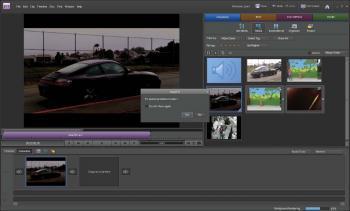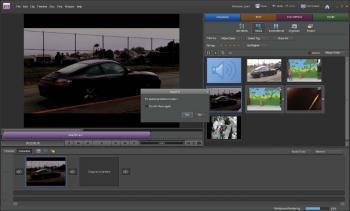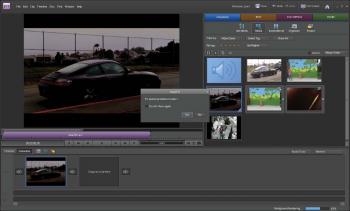When Elements 7 came out, some complained that it didn’t include much in terms of new features. We probably won’t hear similar critiques of Elements 8, as the latest update really takes the product line to a whole new level. The improvements to the file management system alone make the update worthwhile.
Mac users will be glad to hear that Photoshop Elements 8 is now available for the Mac—something Adobe hasn’t offered since Version 6. Premier Elements 8, on the other hand, is still only for the PC.
For this review, I received a copy of the Adobe Photoshop Elements 8 and Adobe Premier Elements 8 package from Adobe. I ran both programs on a PC running Windows Vista, but also did a test run on a Windows 7 virtual machine running on a Mac. Both worked well.
Getting Started With Adobe Elements 8
Like I said, Adobe Elements includes some major changes. But the first thing that really sprung out at me were the changes made to the workflow.
When the program first boots up, it asked me to log into Photoshop.com. At first this seems like a bit of a hassle, but it actually reveals the main change in Elements 8.
The program now works much more closely with online sharing. Just as in previous versions, it comes bundled with 2GB of free storage on Photoshop.com which can be upgraded to 20GB. If you set up your catalog for Backup/Synchronization, all your selected photos and videos will be automatically uploaded to your Adobe Online account.
There are a good number of additional features for exporting images and videos, with tons of new templates for making scrapbooks, photo books, Web sites, greeting cards, and so on. I was rather impressed by the new templates—there are quite a few to choose from, and the presentation would require a pretty hefty wallet to accomplish otherwise. I spent a good while just looking through them all. Three cheers to this one.
My two favorite templates were in the Web image galleries. One animates a growing tree branch where your images appear as leaves. Click on a leaf and the photo enlarges to fill the screen. Another shows a world map with pins to geographically mark your travels. Click on a pin and find the photos from your trip in that locale.
Staying Organized
After logging in, rather than being brought to the application I intended to open, I was taken to the Elements Organizer. This is new. Instead of the simple library known from previous versions, the Elements Organizer now functions as a kind of stand-alone application with a variety of new features. Click on the edit panels for video or photos, and it opens your selected image or video in Premier Elements or Photoshop Elements.
The Elements Organizer has been packed with new features in Elements 8. Among the more helpful are the new sorting features. You can assign tags to photos and videos, for example, naming one “kayaking” or “boating,” and when you type the tag into the file search, all the media with that tag pop up. The tags also appear in a tag cloud, where all of your tags are displayed. Tags that have a lot of associated images or videos will appear in a larger font size than others.
There is also a cool new feature that uses facial recognition to help sort images. If, for example, you type in the name of a particular person in an image, such as cousin Bob who appears in a boating photo, the Elements Organizer will then search through your library and bring up every other file he appears in. The accuracy of this feature is quite good.
From within the organizer you can do automated editing, automatically adjusting color, brightness, and other features of your images. I tried it out on a few photos I took of Wall Street, and found it also to be rather accurate.
To test the speed of the organizer, I imported a large image folder of 422 RAW images. Each photo was around 16MB, with the entire folder totaling about 6.7GB. The Elements Organizer finished the import in less than a minute. For kicks, I then selected all 422 images and clicked on the Auto Smart Fix tool to edit every single image. It took about 12 seconds per photo, which wasn’t bad given that the images were really large.
Editing Images and Videos
When you click on the edit tabs for either video or photos, the Photoshop or Premier Elements applications opens in a separate window where you can make more precise edits. After making and saving changes, the image or video is updated on the Elements Organizer.
There are a few new features in Premier Elements 8 and Photoshop Elements 8. The key new feature in Photoshop Elements is the Recompose tool, which allows for advanced image reshuffling. You can, for example, move a subject closer to another without distorting the image. I tried it on a photo I took of an old man feeding a flock of pigeons, and found the feature to work surprisingly well, with little distortion.
For Premier Elements, there are a couple of key features that have been added. The best, in my opinion, is the new auto analysis tool which will go through a video and pick out any parts that are questionable, such as segments that are shaky, overexposed, or blurry. These sections are marked so that you can decide whether to delete problem segments without having to go through the whole video.
There is also a new motion tracking feature that allows you to add animations and such to subjects in a video, which will then follow the subject. This could be used, for example, to add a thought bubble that will follow someone around in a video.
In a Nutshell
Much like my review of Elements 7 last year, the Elements 8 package is one of the best deals on the market. You get the main features of two of Adobe’s key products at a fraction of the price and in a workspace that is much easier to use than the CS4 versions.
For current Elements users, this update is well worth your time. For those who are looking for a good program for image and video editing that isn’t too expensive, look no further.
[etDetailsBox Score Card:]
Effectiveness: B+
Interface: A-
Usability: A-
Installation: A
Overall: A-
[/etDetailsBox]






![[LIVE Q&A 04/30 at 10:30AM ET] Major Government Policy on the Internet Passed](/_next/image?url=https%3A%2F%2Fimg.theepochtimes.com%2Fassets%2Fuploads%2F2024%2F04%2F29%2Fid5640068-CR-TN_REC_0430-1080x720.jpg&w=1200&q=75)


